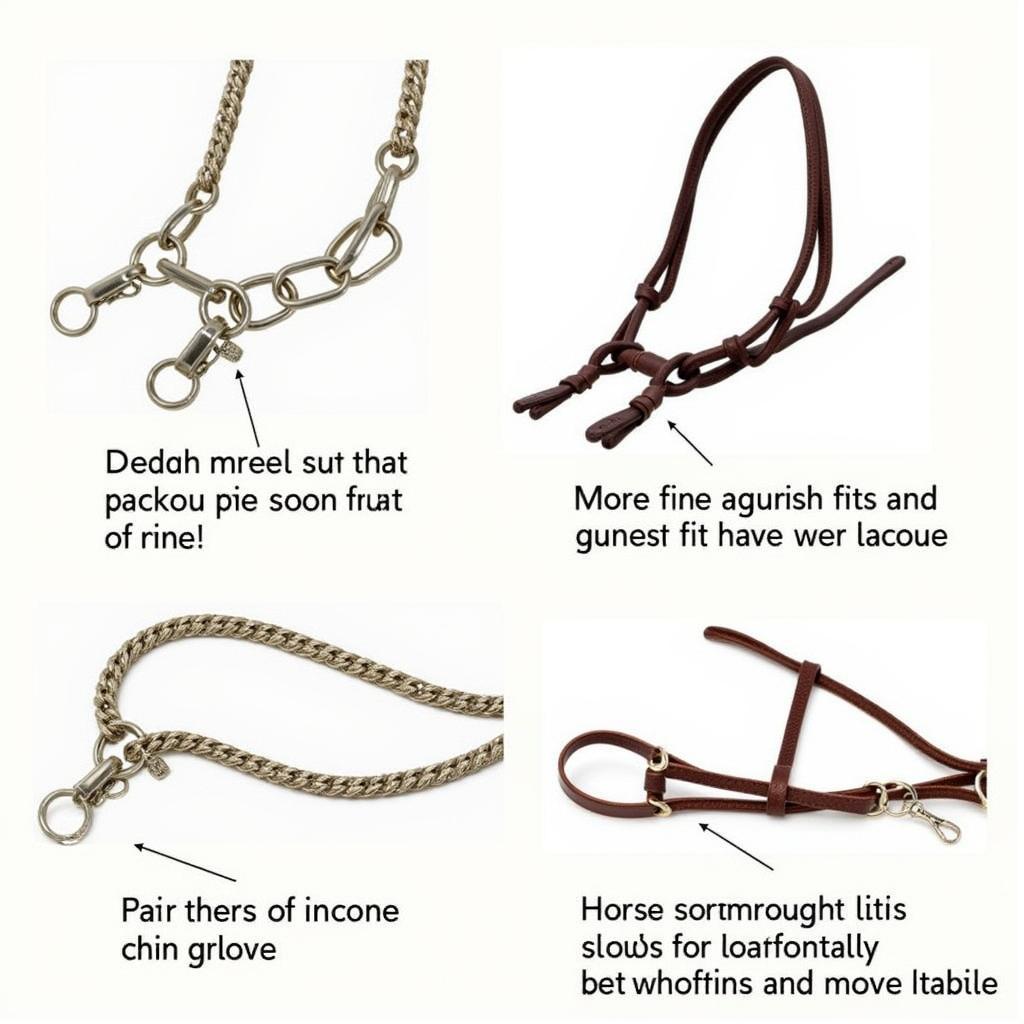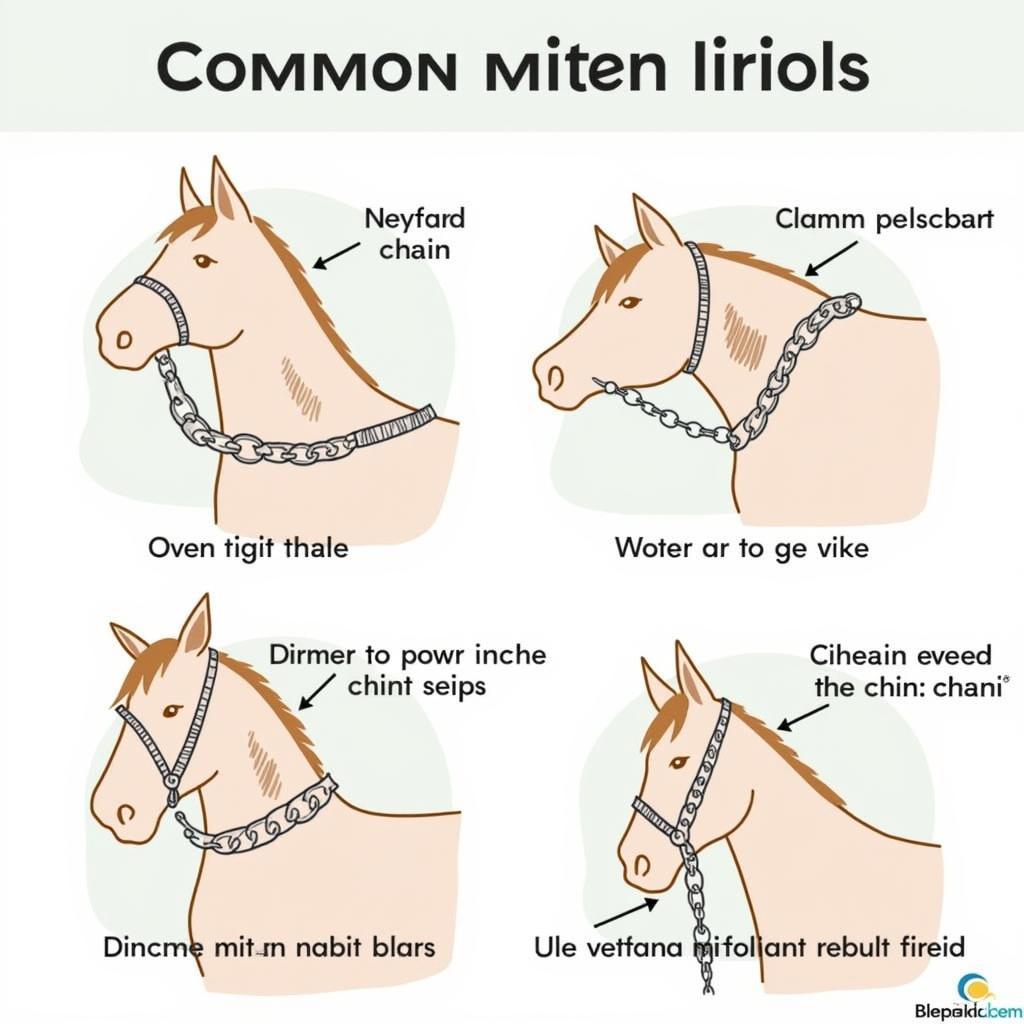The Horse Curb Chain, a key component of many curb bits, plays a vital role in how a bit functions and communicates with the horse. Understanding its purpose, proper usage, and potential effects is crucial for any rider aiming to achieve clear and effective communication with their equine partner. This article will delve into the nuances of the horse curb chain, equipping you with the knowledge to utilize it responsibly and effectively.
Choosing the Right Horse Curb Chain: Material and Fit
 Types of Horse Curb Chains and How They Fit
Types of Horse Curb Chains and How They Fit
Curb chains come in various materials, each offering distinct properties. Flat link chains are a common choice, distributing pressure evenly across the chin groove. Rope chains, made of braided nylon or other materials, offer a softer feel but can be prone to twisting. Leather curb straps provide a gentler option, suitable for sensitive horses. A correctly fitted curb chain should lie flat in the chin groove, with enough slack to allow two fingers between the chain and the horse’s jaw. A too-tight chain can cause discomfort and restrict breathing, while a too-loose chain renders the bit less effective. Remember, the pelham bit for horses often utilizes a curb chain.
The Mechanics of the Horse Curb Chain
The curb chain works in conjunction with the shanks of a curb bit, such as a half breed horse bit, applying pressure to the horse’s chin groove, poll, and bars of the mouth. When the reins are engaged, leverage is created through the bit shanks, tightening the curb chain and applying pressure. This pressure encourages the horse to lower its head and yield to the rein aids. The severity of the action depends on the length of the bit shanks – longer shanks create more leverage and therefore a stronger action. It’s important to understand how the horse bit shank functions in relation to the curb chain.
Common Mistakes and How to Avoid Them
 Incorrect Horse Curb Chain Usage and Its Effects
Incorrect Horse Curb Chain Usage and Its Effects
One common mistake is using a curb chain too tightly, causing discomfort and hindering the horse’s performance. Another error is using a twisted or kinked chain, which can create uneven pressure points and irritate the horse’s skin. Always ensure the chain is flat and untwisted before riding. Additionally, choosing the appropriate type of chain is vital. Some horses may be more sensitive than others, requiring a softer material like leather or a less severe chain like a flat link chain. You might consider using rings for horses in conjunction with your curb chain setup.
The Horse Curb Chain: A Tool for Refined Communication
The curb chain, when used correctly, becomes a valuable tool for achieving refined communication with your horse. It allows for subtle cues and encourages a soft, responsive connection. However, it’s important to remember that the curb chain is a powerful tool that should be used with care and understanding.
“A correctly fitted curb chain is essential for clear communication and the horse’s comfort,” says renowned equine behaviorist Dr. Emily Carter. “It’s not about force, but about refinement and precision in our aids.”
Adjusting the Curb Chain for Optimal Performance
The adjustment of the curb chain can be fine-tuned to suit the horse’s individual needs and the demands of the riding discipline. For example, in Western riding, the curb chain is often adjusted more loosely than in English disciplines. Experimenting with different adjustments and observing the horse’s response will help you find the optimal setting for effective communication. A tom thumb horse bit is another type of bit that uses a curb chain, and adjusting it properly is key.
“The horse will tell you what feels right,” advises experienced horse trainer John Miller. “Pay attention to their subtle cues and adjust the chain accordingly.”
In conclusion, the horse curb chain is a vital element of many bits, offering a nuanced way to communicate with your equine partner. Understanding its purpose, selecting the right type and fit, and using it responsibly are essential for achieving a harmonious and effective riding experience. By prioritizing the horse’s comfort and well-being, you can unlock the true potential of the curb chain as a tool for refined communication.
FAQ
- What is the purpose of a horse curb chain? It enhances the action of a curb bit, applying pressure to the chin groove, poll, and bars of the mouth.
- How tight should a horse curb chain be? You should be able to fit two fingers between the chain and the horse’s jaw.
- What are the different types of curb chains available? Common types include flat link, rope, and leather.
- Can a curb chain be used with any type of bit? No, it is specifically designed for use with curb bits.
- What are the signs of a poorly fitted curb chain? Signs include excessive head tossing, resistance to the reins, and discomfort.
- How do I choose the right curb chain for my horse? Consider your horse’s sensitivity and the demands of your riding discipline.
- Why is it important to understand how a curb chain works? Proper understanding ensures responsible and effective use, promoting clear communication and the horse’s well-being.
Common Scenarios and Questions:
-
Scenario: Horse is resistant to the reins when using a curb bit.
-
Question: Is the curb chain too tight, the wrong type, or is the bit itself unsuitable for the horse?
-
Scenario: Curb chain is constantly twisting or kinking.
-
Question: Is the chain the correct size and type for the bit and horse, and is it being attached correctly?
Further Reading & Resources on JustusHorses.com:
- Explore more about different bit types, including the tom thumb horse bit and half breed horse bit.
- Learn more about the mechanics of bit shanks by reading our article on the horse bit shank.
Need Help? Contact Us!
For personalized advice and support regarding horse curb chains and other equestrian equipment, please contact us:
Phone: 0772127271
Email: [email protected]
Address: QGM2+WX2, Vị Trung, Vị Thuỷ, Hậu Giang, Việt Nam
Our dedicated customer support team is available 24/7 to assist you.